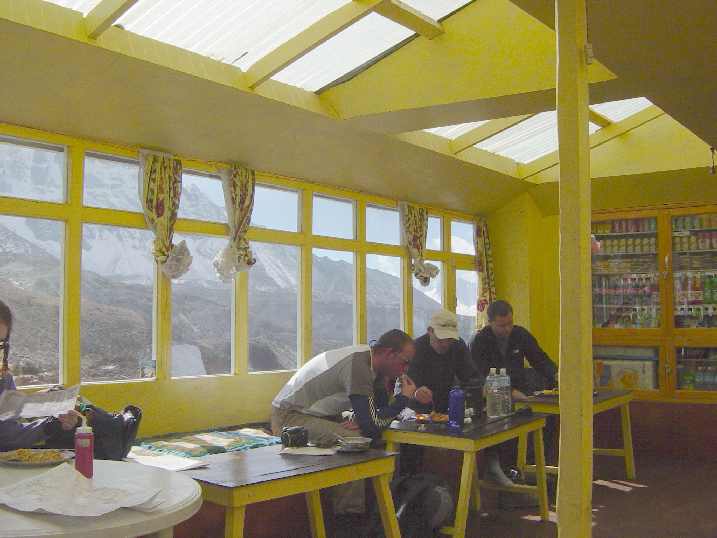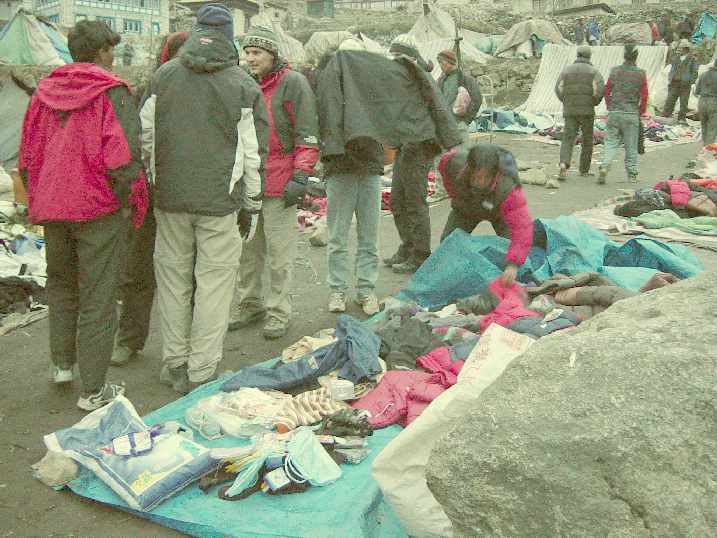
Saturday morning I headed to the airport for the two and a half hour flight from Tashkent to Delhi using my frequent flier kilometers on Uzbekistan Airways. I was a bit worried about my one hour flight from Delhi to Kathmandu that afternoon because I did not have a ticket, only a reservation. It seems that Royal Nepal Airlines does not sell tickets through many travel agents so I could not buy it over the internet or in Tashkent. But the folks at Uzbekistan Airways told me not to worry, they had confirmed the reservation "no problem". I arrived at the Delhi airport, went through customs and asked a guard where to buy my ticket. A helpful young many showed me the way up a narrow corridor to an office with a sign "Royal Nepal Airlines" and a big padlock on the door. So the young man said "follow me" and we went outside and got on an autorickshaw (a three-wheel motorcycle) and he took me on a long drive to a travel agent who tried to convince me to pay him $40 cash to arrange an e-ticket that I would buy back at the airport. I declined and returned to the airport where a man outside the Royal Nepal Airlines office said it would open soon. Sure enough, he directed me to an ATM machine to get Indian Rupees, I bought my ticket and late that night I arrived in Kathmandu where I was greeted by a representative of the trekking company who took me to the hotel.
Sunday morning I met with the other five people who would go on this trek. They ranged in age from 28 to 42 and included guys from California, England and Denmark and a couple living in Scotland. I made a list of things to buy and started exploring the narrow busy streets of Kathmandu.
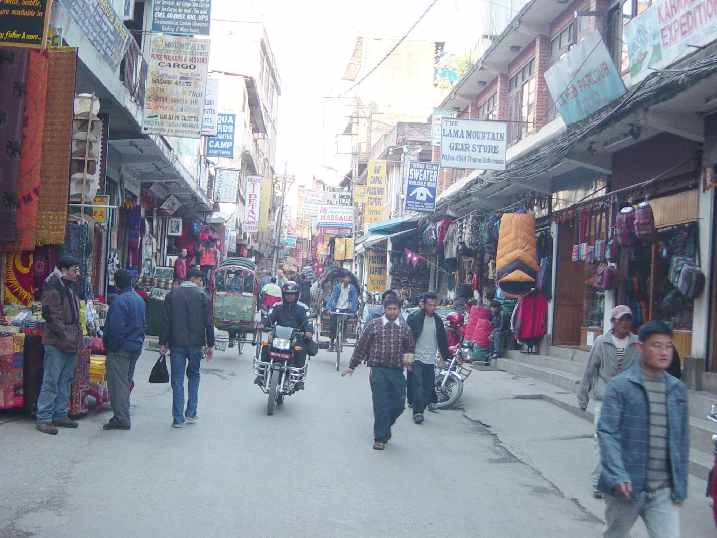
I found an ATM machine to get some Nepalese Rupees then bought a walking stick, a small headlamp, iodine to purify the water, toilet paper, a cigarette lighter to burn the toilet paper following use and some snack food.
The next morning, after an early breakfast, we all piled into a van and went to the airport for the half-hour flight to Lukla, in the foothills of the Himalayas. Kathmandu was enveloped in fog, but the representative from the trekking company said this was normal early in the morning. We arrived at the domestic terminal of the airport and joined dozens of other trekkers and a handful of Nepalese waiting for flights. The sign above the Yeti Airline counter said "all flights delayed due to weather in Kathmandu."

Eventually we saw the sun shining through a window, we heard some planes take off and there were signs of life at the Yeti Airlines counter. Other people were checking their baggage but they told us to wait. Around Noon they said, OK let's go, we checked our baggage, got our boarding passes, went through security (where they confiscated my new cigarette lighter) and moved to the next waiting room in the boarding area. They called Luka and we went to the door but they said that we were on the second Lukla flight so we watched a group of Austrian trekkers head out to the plane. We waited for another hour until it was announced that all flights to Lukla today are cancelled. The Austrian trekkers came back from their plane and joined us in retrieving our baggage, we called the trekking company and returned to the hotel.
We asked about the possibility of getting a helicopter to take us to Lukla. Several companies offered helicopter service, but for a group our size the cost was very high. We tried to find the bigger Austrian group to find out what they were doing but couldn't track them down. Many of you are probably wondering why we didn't just drive to Lukla -- a good question. Unfortunately there are no roads to Lukla. You can drive to Jeri, but then it takes a week to walk to Lukla!
Tuesday morning we piled into the van at about 7:00 and returned to the airport. The weather looked much better. Still we spent the morning in the same two rooms, waiting. But at Noon they called our flight drove us to an 18 passenger propeller plane and finally we climbed in and we were off to Lukla. We flew over densely populated rugged valleys where farmers had leveled the land into steps so that they could grow some food. We peeked through the clouds and saw snow-covered mountains in the distance including, one passenger claimed, Mt. Everest. After a short flight we landed at the tiny Lukla airport. The runway went steeply up the hill to help slow landing planes and give those taking off an extra boost before they headed off the edge.
(I took the last picture at the end of the trek -- the day we started it was much cloudier)
We got off the plane and were met by our guide Ginnis, our assistant guide Gopal and three porters who grabbed our bags and crossed the street to the Sherpa's Lodge for lunch. We ordered the traditional Nepalese dish of Dal Bat, lots of rice with some spicy beans, cabbage and other vegetables. Almost an hour later our lunch arrived, we ate quickly and began our trek. By now it was late afternoon, but the five mile walk was mostly downhill, passing through many villages and several Buddhist monuments and we arrived at our lodge in Phakding shortly before dark. (I'm not sure why they spell Phakding and many other names with a "ph" when they go from Hindu to English -- it is pronounced "Pakding".)
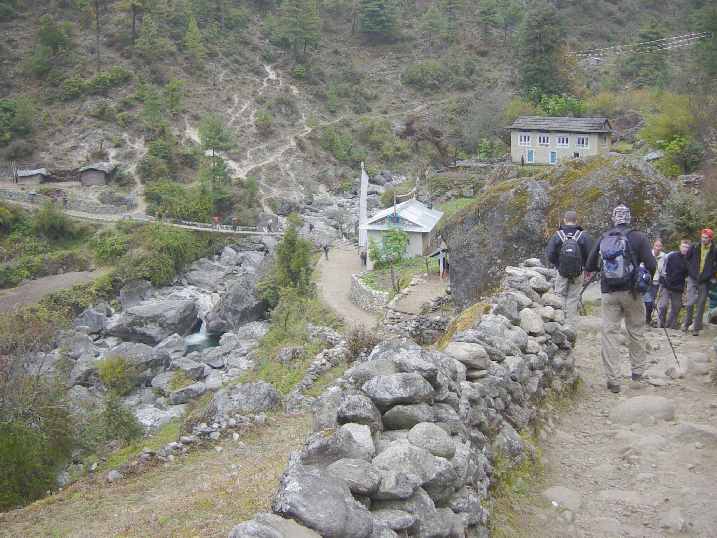
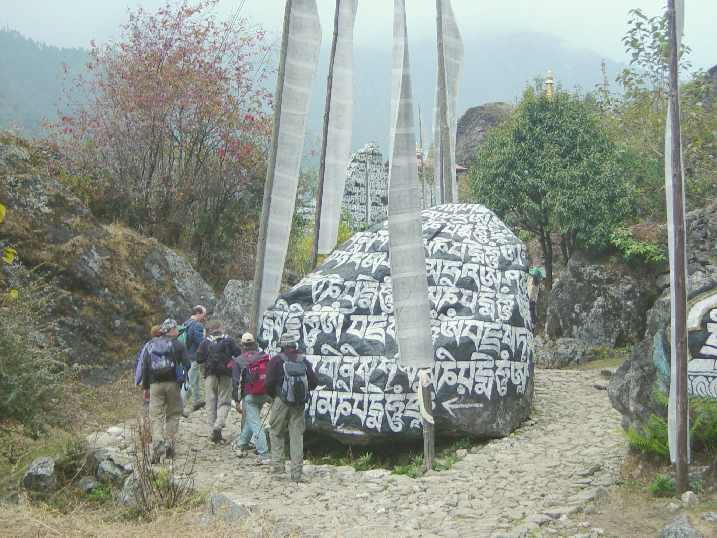
At 6:00 the next morning, Gopal woke us up and offered us cups of tea in bed, the traditional Sherpa way of starting the day. I thought it was still quite early when at about 8:00 the porters took our duffles, we took our small day packs and we started up the trail. Since there are no roads and the trails are too rugged for anything with wheels, porters carry most goods to these villages. Yaks are also used to carry loads, but they walk more slowly than people and don't seem to carry much more than a strong porter.
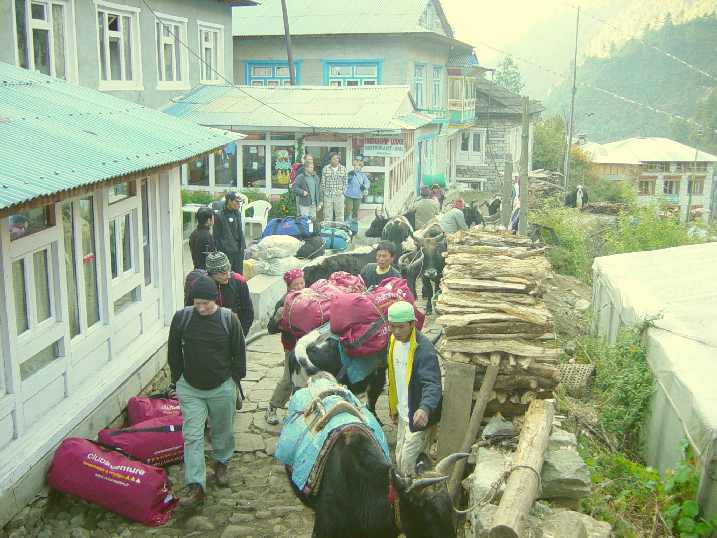
We followed the Dudh River valley all morning, climbing up then dropping back down and crossing the river several times on high but sturdy suspension bridges.
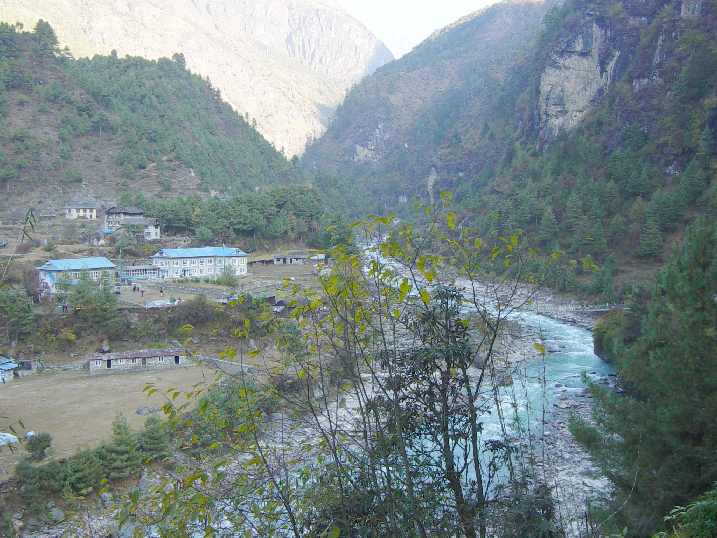
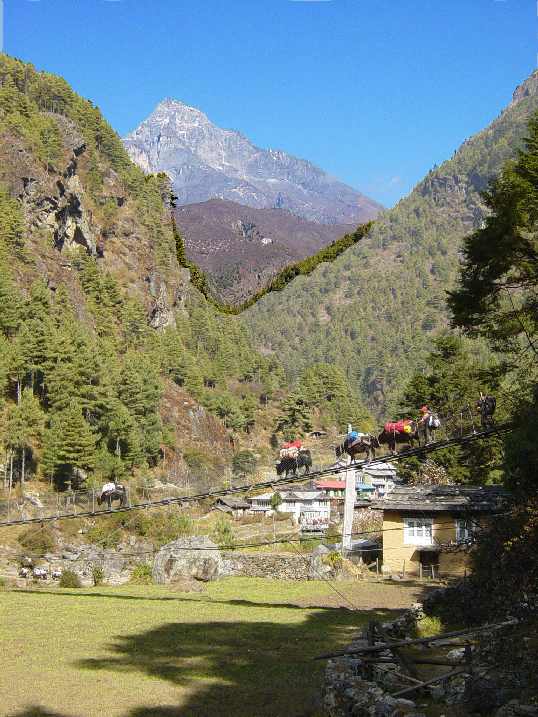
The airport at Lukla is about 9200 feet above sea level but we had dropped to 8600 feet in Phakding. After following the river upstream all morning and entering the national park, it was time to leave the valley and climb to Namche Bazaar at 11,700 feet. That was a steep climb for me in the thin air and I was tired. Half way up we got our first peak of Mr. Everest in the distance.
Early in the afternoon we arrived in Namche Bazaar, a large village perched in a bowl on the side of a mountain. Many traders come here from Tibet as there is a trail over a pass that ends here and there is a big bazaar in the center of the bowl. Nepalese from nearby villages come here to sell their crops and to purchase supplies. They have a small hydro-electric plant for energy. At this elevation they say that you should not climb more than 1000 feet per day and that you should periodically take an extra say for "acclimatization". So we spent the next day exploring Namche Bazaar and the surrounding area. That night it had snowed a bit and all day the weather was cloudy with snow flurries, so it seemed like a good day to explore.

We admired the view back down into the valley we had climbed out of yesterday. Looking carefully we could even see the suspension bridge we had crossed.
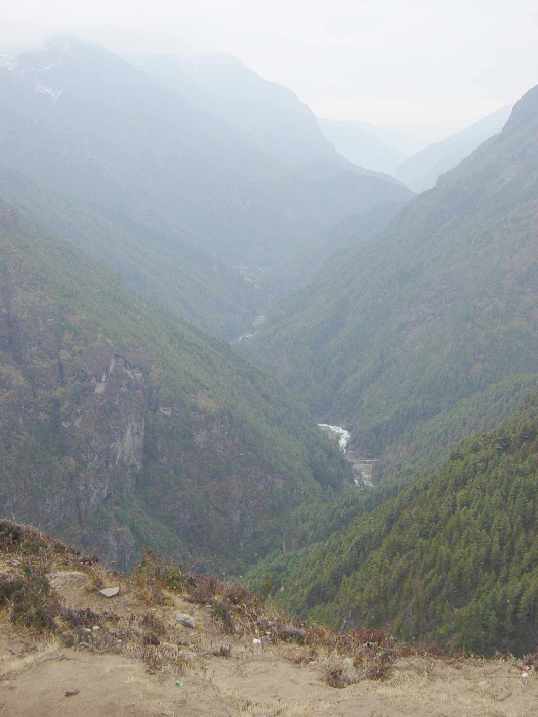
At one of the shops the manager said that her brother's son had attended Fryeburg Academy in Maine!

The next morning the weather had cleared and we climbed further up the side of the mountain. After a very steep climb tht probably didn't really take more than an hour but felt much longer, we came upon a field of yaks grazing.
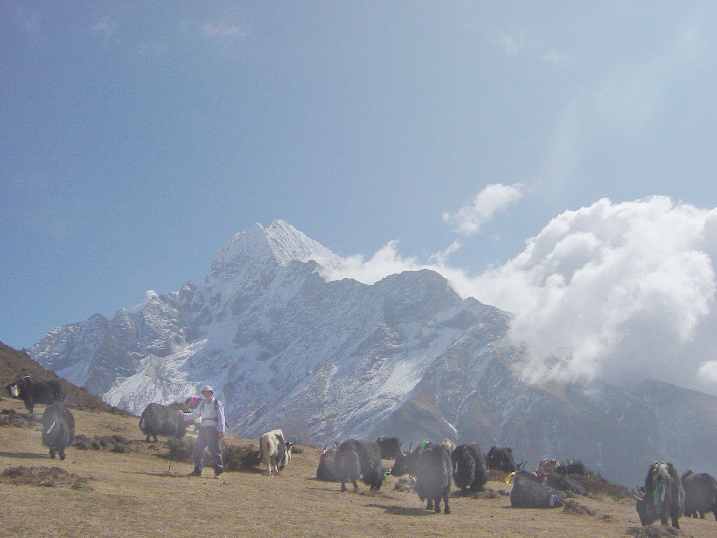
After a bit more climbing we came to a point called Everest View. We saw a beautiful view of Ama Dablam (the impressive looking peak on the right that is actually more difficult to climb than Everest because it much steeper), but a tiny cloud covered Everest, just left of the center. Then we posed with our guide Ginness

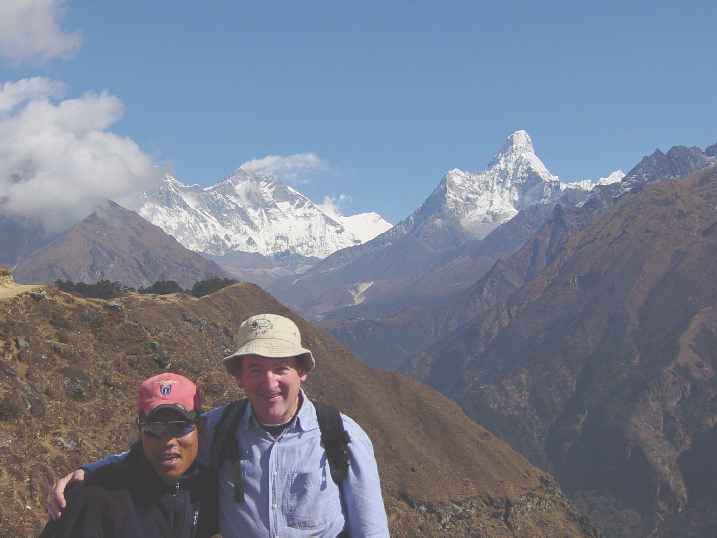
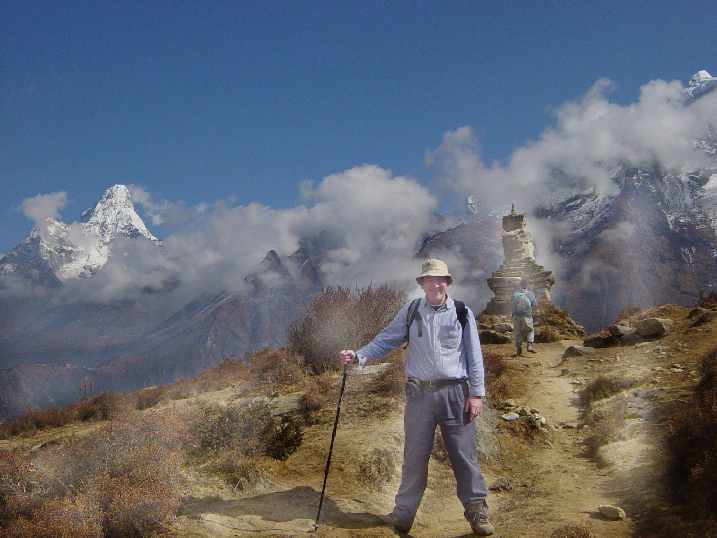
After relaxing and enjoying the view for a while, we hiked down to the village of Khumjung. Sir Edmund Hillary helped establish a boarding school there so that Sherpa children would not have to go to Kathmandu to get a good education. Many of the villages have elementary schools but I think there are few high schools. The boys from the school organized a vigorous game of badminton. The other attraction of the village is a monastery with the skull of yeti, a close relative of Washington's abominable snowman. We paid a dollar to see the skull but were not terribly impressed. We did enjoy the colorful decorations of the monastery.
The next morning several of us got up before breakfast and walked back to the Everest View Point. Now the cloud was gone and we got to see the mountain.
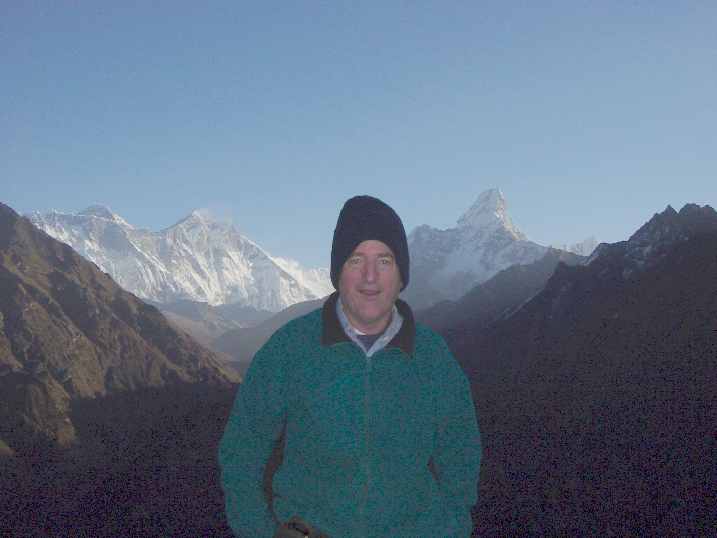
After breakfast we hiked down and down until we crossed the river again -- further upstream than our previous crossing but still a long way down. At lunch we watched stone masons hard at work, chipping stones to make them fit then putting them into place. The suspension bridges seemed sturdy and had good side rails, but I still did not enjoy the way they bounced and swayed in the wind. After lunch we started back up the other side of the valley. The trail was crowded with trekkers, porters, yaks and others just heading for the next village.
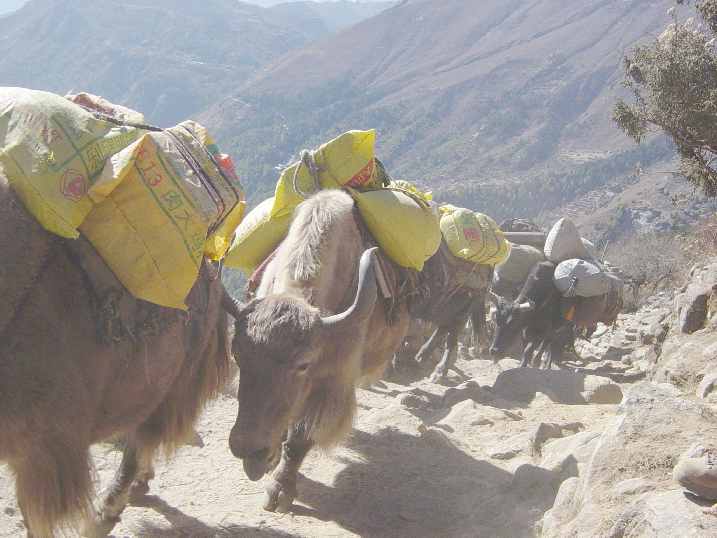
We all walked slowly up the mountain. The thin air doubtless slowed us, but so did the knowledge that we were only going back up to the height we had been early that morning. Finally, we crossed over to the top of the ridge and found a large clearing with a monastery and several lodges. And there was Everest, staring at us over the top of one of the buildings, looking much closer than it had in the morning. Now there seemed to be nothing blocking our way to the top of the world!


We were pleased to find a bakery that made excellent cinnamon rolls. I was not surprised to see a gift shop selling postcards. The surprise was the mail box -- if you bought a stamp for 18 rupees (about 25 cents), a porter would pick up your postcard and carry it back to the airport in Lukla and then send it on its way the the US. So I sent a couple postcards.
After admiring the view and eating out treats from the bakery we explored the monastery. The head monk here seems to be quite important, sort of the Pope of the Everest Region. In the morning before breakfast I returned for a part of the service -- I slept to long to see the drums and horns. By the time I arrived they were only sitting and chanting. I didn't stay long.
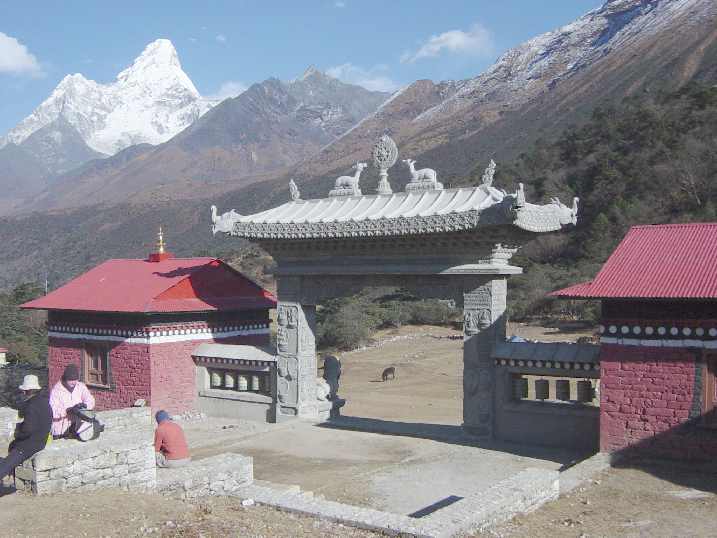
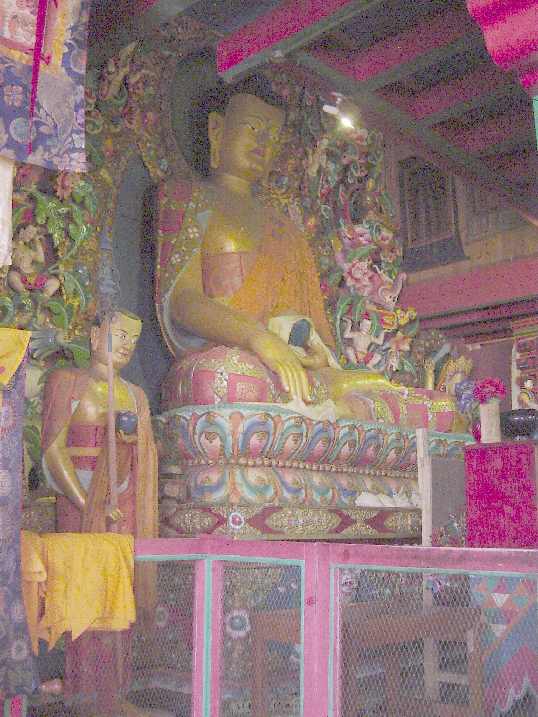
The next morning we hiked down into the valley again, but further upstream. When we stopped for lunch we were below the ridge with the monastery, but Everest was getting closer.
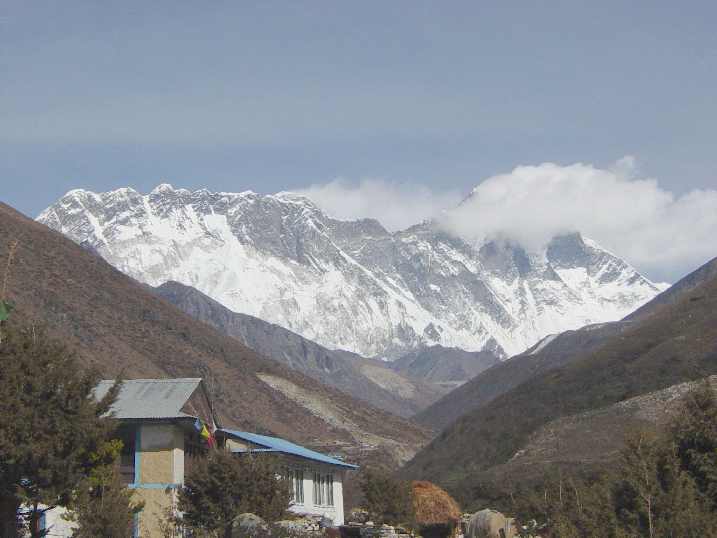
After lunch we followed the river for most of the day to the village of Dingboche. We were 1600 feet higher than we had been at the monastery (now 14,400 feet). It was cold and windy and there were few trees. Now it was time for another acclimatization day. The next morning we hiked further up the valley that was now broad and high. It was much more desolate and we were pleased to find a lodge at lunch time with windows to let us admire the view and soak in the sunlight.

